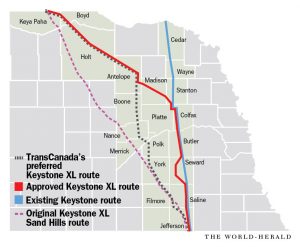
A new government report says the new route for a planned Keystone XL pipeline through Nebraska would not have a major impact on the state’s water, land and wildlife.
The U.S. State Department released a draft study this week of the potential environmental impact in Nebraska where opponents have strongly opposed the 1,184-mile oil pipeline. The study will now be subject to public input through Aug. 29 before it is finalized.
Environmentalists and Native American tribes have prevented TransCanada from moving ahead with construction. Their latest effort involves a lawsuit pending before the Supreme Court in Nebraska. But oral arguments are not expected until October and it will likely take months for a decision to be reached.
If approved and constructed, it would be the second Keystone pipeline to carry oil to the Gulf coast. The first was completed in 2014 and has been carrying oil out of the state without any interruptions or spills.
TransCanada spokesman Matt John told the Associated Press the company will review the environmental assessment “and provide comment to the Department of State as necessary.”
The report said most of the disruption would take place during pipeline construction and would have a “moderate” impact at most, and in those cases, crews could mitigate the damage. TransCanada has said it will compensate affected landowners for damage, although opponents say the company isn’t offering enough.
“It is estimated that disturbed pastures, croplands and grassy rangelands may take one to five years to recover to pre-construction levels,” the report said.
The president of a leading pipeline opposition group said she was concerned that the State Department wouldn’t schedule any public hearings on the new route. In 2011, State Department hearings in Nebraska drew hundreds of supporters and opponents of the project.

“For me, this is one more sign that the Trump administration doesn’t care about property rights,” said Jane Kleeb, who has fought the project for years.
The Trump administration signed a federal permit for the project in March 2017, reversing the Obama administration’s decision to reject the company’s request. But a new federal review was needed because Nebraska state regulators approved a substantially different route in November than the one the State Department had initially studied.
The new route approved by the Nebraska Public Service Commission is five miles longer than the original proposed pathway, requires an additional pumping station and runs next to an existing TransCanada-owned pipeline for nearly 89 miles.
The pipeline would carry up to 830,000 barrels of crude oil per day from Canada to Steele City, Nebraska, where it would connect with the original Keystone pipeline that runs down to Texas Gulf Coast refineries.
The State Department’s new report noted two major spills in South Dakota involving the original Keystone pipeline, which went into operation in 2010, but added that TransCanada has a lower overall spill rate than average in the oil pipeline industry.
Crews have replaced all of the contaminated soil and reseeded the affected farmland after the November 2017 spill in Marshall County, South Dakota, according to the report. Another spill near Freeman, South Dakota, in April 2016 led to increased supervision of the pipeline in that area, and nearby aquifers were not affected, the report said.




